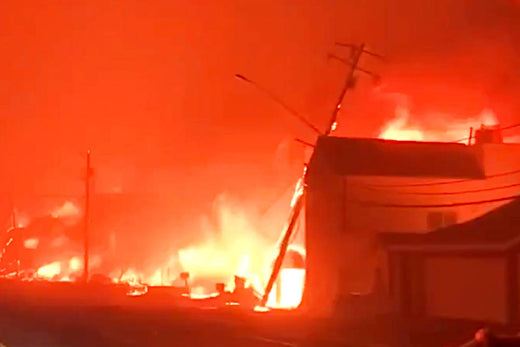
Seit dem 10. Januar 2025 kämpft Los Angeles mit einer Reihe beispielloser Waldbrände, die zu erheblichen Verlusten an Menschenleben, Sachschäden und Umweltschäden geführt haben. Die Hauptbrände – Palisades, Eaton, Hurst und Kenneth – haben zusammen Zehntausende Hektar Land verwüstet, mindestens zehn Todesopfer gefordert und über 10.000 Gebäude zerstört.
Palisades-Feuer
Das Palisades-Feuer brach in der Nähe des Viertels Pacific Palisades aus und breitete sich rasch aus. Es vernichtete rund 2.000 Hektar Land. Entlang des Pacific Coast Highway und angrenzender Gebiete wurden Evakuierungen angeordnet. Das Westwood Recreation Center wurde als Notunterkunft für Evakuierte eingerichtet. Die schnelle Ausbreitung des Feuers, das zeitweise drei Fußballfelder pro Minute erreichte, wurde durch starken Wind und Trockenheit noch verstärkt. Bei einer Überprüfung der Sozialleistungen wurden in einem zerstörten Wohnhaus in Malibu menschliche Überreste entdeckt.
Eaton Feuer
Der Eaton-Brand war besonders verheerend und zerstörte zahlreiche Gebäude, darunter den Pasadena Jewish Temple and Center. Die schnelle Ausbreitung des Feuers stellte die Eindämmungsbemühungen vor erhebliche Herausforderungen. Die Feuerwehrleute kämpften um den Schutz von Wohngebieten und kritischer Infrastruktur.
Hurst Feuer
Das Hurst-Feuer begann in der Gegend von Sylmar und breitete sich rasch über eine Fläche von 340 Hektar aus. Für die Gebiete nördlich des Foothill Freeway wurden umgehend Evakuierungsbefehle erlassen. Jüngsten Berichten zufolge waren die Eindämmungsmaßnahmen zu etwa 37 % erfolgreich, die Lage bleibt jedoch aufgrund wechselnder Winde und des schwierigen Geländes weiterhin instabil.
Kenneth Fire
Der Kenneth Fire, der am 9. Januar in der Nähe von West Hills gemeldet wurde, breitete sich rasch auf 960 Acres aus und bedrohte Vororte in Calabasas und Hidden Hills. Es kam zu obligatorischen Evakuierungen und zusätzlichen Feuerwehrkräften. Der Brand wird derzeit wegen möglicher Brandstiftung untersucht; eine Person wurde im Zusammenhang damit festgenommen.
Beitragende Faktoren
Die Schwere dieser Waldbrände kann auf mehrere miteinander verbundene Faktoren zurückgeführt werden:
-
Santa-Ana-Winde : Die außergewöhnliche Intensität der Santa-Ana-Winde mit Böen von bis zu 135 km/h in bestimmten Gebieten hat erheblich zur schnellen Ausbreitung der Brände beigetragen.
-
Dürre : Südkalifornien leidet unter schwerer Dürre. Einige Regionen erleben den trockensten Beginn der Regenzeit seit Beginn der Wetteraufzeichnungen. Die Folge ist eine stark ausgetrocknete Vegetation, die reichlich Nährboden für die Waldbrände bietet.
-
Klimawandel : Studien deuten darauf hin, dass der Klimawandel die Temperaturen erhöht und die Niederschlagsmengen in der Region schwanken lässt. Dürren, unterbrochen von Perioden mit starkem Regen, führen zu plötzlichem Wachstum der Vegetation, die schnell austrocknet und so Waldbrände begünstigt.
Auswirkungen auf die Gemeinschaften
Die Waldbrände hatten schwerwiegende Auswirkungen auf die örtlichen Gemeinden:
-
Evakuierungen : Über 100.000 Einwohner mussten evakuiert werden, viele suchten Zuflucht in Notunterkünften. Die schnelle Ausbreitung der Brände ließ den Bewohnern kaum Zeit, ihr Hab und Gut in Sicherheit zu bringen, was zu erheblichen persönlichen Verlusten führte.
-
Gebäudeschäden : Neben Wohnhäusern wurden auch mehrere Wahrzeichen und kulturelle Einrichtungen zerstört, darunter die historische Will Rogers Ranch und der Malibu Feed Bin.
-
Wirtschaftliche Auswirkungen : Die wirtschaftlichen Folgen sind erheblich. Die Verluste belaufen sich auf fast 57 Milliarden US-Dollar. Dazu gehören Schäden an der Infrastruktur, der Verlust von Häusern und Unternehmen sowie die Kosten für die Brandbekämpfung.
Fehlinformationen und öffentliche Reaktion
Die Krise wurde durch die Verbreitung von Fehlinformationen noch verschärft:
-
Desinformationskampagnen : Bekannte Persönlichkeiten verbreiteten falsche Informationen über die Ursachen der Brände und die Wirksamkeit der Löscharbeiten. Dies führte zu Verwirrung in der Öffentlichkeit und lenkte die Aufmerksamkeit von den unmittelbaren Bedürfnissen der betroffenen Gemeinden ab.
-
Unterstützung durch die Bevölkerung : Trotz der Herausforderungen gab es große Unterstützung durch die lokale Bevölkerung und internationale Hilfe. Spendenaktionen wurden gestartet, um den Obdachlosen zu helfen, und Ressourcen für die Feuerwehreinsätze werden mobilisiert.
Regierung und Notfallmaßnahmen
Die lokalen und bundesstaatlichen Behörden haben verschiedene Maßnahmen zur Bewältigung der Krise ergriffen:
-
Einsatz von Ressourcen : Gouverneur Gavin Newsom hat zusätzliche 900 Feuerwehrleute zur Bekämpfung der Brände entsandt. Präsident Biden hat Bundesmittel zur Unterstützung der Brandbekämpfung bewilligt, und internationale Hilfe ist eingetroffen, um die Maßnahmen zu verstärken.
-
Evakuierungsbefehle und Ausgangssperren : Um die öffentliche Sicherheit zu gewährleisten, wurden für die am stärksten betroffenen Gebiete Evakuierungsbefehle erlassen und es laufen Diskussionen über die Einführung von Ausgangssperren, um Plünderungen zu verhindern und für Ordnung zu sorgen.
Umwelt- und Gesundheitsbedenken
Die Waldbrände haben zu erheblichen Umwelt- und Gesundheitsproblemen geführt:
-
Luftqualität : Die Brände haben in Los Angeles und Umgebung zu einer gefährlichen Luftqualität geführt und stellen ein Gesundheitsrisiko für die Einwohner dar, insbesondere für diejenigen mit bereits bestehenden Atemwegserkrankungen.
-
Wasserressourcen : Die Belastung der Wasserressourcen ist enorm, da die Löscharbeiten einen erheblichen Wasserverbrauch erfordern und die Vorräte aufgrund der Dürre bereits knapp sind.
War dieser Artikel hilfreich für Sie? Bitte teilen Sie uns in den Kommentaren unten mit, was Ihnen gefallen oder nicht gefallen hat.
About the Author: Alex Assoune
Wogegen Wir Kämpfen
Weltweit-Konzerne produzieren in den ärmsten Ländern im Übermaß billige Produkte.
Fabriken mit Sweatshop-ähnlichen Bedingungen, die die Arbeiter unterbezahlt.
Medienkonglomerate, die unethische, nicht nachhaltige Produkte bewerben.
Schlechte Akteure fördern durch unbewusstes Verhalten den übermäßigen Konsum.
- - - -
Zum Glück haben wir unsere Unterstützer, darunter auch Sie.
Panaprium wird von Lesern wie Ihnen finanziert, die sich unserer Mission anschließen möchten, die Welt völlig umweltfreundlich zu gestalten.
Wenn Sie können, unterstützen Sie uns bitte monatlich. Die Einrichtung dauert weniger als eine Minute und Sie werden jeden Monat einen großen Beitrag leisten. Danke schön.































0 Kommentare